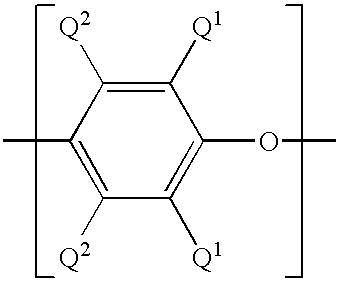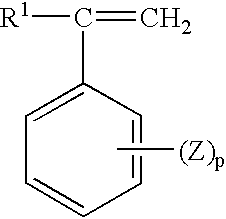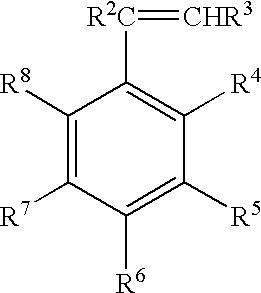Method for the preparation of a poly(arylene ether)-polyolefin composition, and composition prepared thereby
a poly(arylene ether) and polyolefin technology, applied in the field of poly(arylene ether)polyolefin compositions, can solve the problems of inadequate compositions for many commercial uses
- Summary
- Abstract
- Description
- Claims
- Application Information
AI Technical Summary
Problems solved by technology
Method used
Image
Examples
examples 4-10
Using the same formulation as above, samples were compounded with process variations including the intensities of upstream and downstream mixing, the extruder barrel temperature, the screw rotation rate ("RPM"), and the throughput rate. For all samples, PPE, xPS, SBS, SEBS, and PP-g-PS were added upstream, and PP and EPR were added downstream. Results are presented in Table 3.
example 11
A composition was compounded using the formulation detailed in Table 4. SEBS H1043 is a hydrogenated styrene-butadiene-styrene triblock copolymer having 66 weight percent polystyrene and obtained in pellet form as TUFTEC.RTM. H1043 from Asahi Chemical. All component amounts are expressed in parts by weight. Upstream mixing employed six mixing elements on each screw shaft; downstream mixing employed three mixing elements on each screw shaft. Except for EPR and 75% of the PP, which were added downstream, all components were added upstream to the extruder. The extruder barrel temperature was 288.degree. F., and the screw rotation rate was 450 RPM. Properties were measured as discussed above, and results are given in Table 4.
examples 12-47
These examples collectively illustrate the effect of mixing energy input on properties of a single composition.
The composition is summarized in Table 5; all amounts are in units of weight percent, based on the total composition. Components were as specified in Table 1, except that EPR was obtained as PROFAX 7624 from Montell Polyolefins, which is a heterophasic / pre-dispersed blend of about 20 weight percent EPR in polypropylene; polypropylene (PP) was a combination of PD403 obtained from Montell Polyolefin and the 80 weight percent polypropylene content of PROFAX 7624.
Compositions were extruded using upstream additions of all components except for EPR and PP, which were added downstream. The barrel temperature was 500.degree. F. for all samples. Mixing energy input was varied by changing the number of downstream mixing elements in the extruder and by changing the extruder screw speed and the total feed rate of all components. The energy input for each example was calculated accordin...
PUM
| Property | Measurement | Unit |
|---|---|---|
| temperature | aaaaa | aaaaa |
| weight percent | aaaaa | aaaaa |
| weight percent | aaaaa | aaaaa |
Abstract
Description
Claims
Application Information
 Login to View More
Login to View More - R&D
- Intellectual Property
- Life Sciences
- Materials
- Tech Scout
- Unparalleled Data Quality
- Higher Quality Content
- 60% Fewer Hallucinations
Browse by: Latest US Patents, China's latest patents, Technical Efficacy Thesaurus, Application Domain, Technology Topic, Popular Technical Reports.
© 2025 PatSnap. All rights reserved.Legal|Privacy policy|Modern Slavery Act Transparency Statement|Sitemap|About US| Contact US: help@patsnap.com



